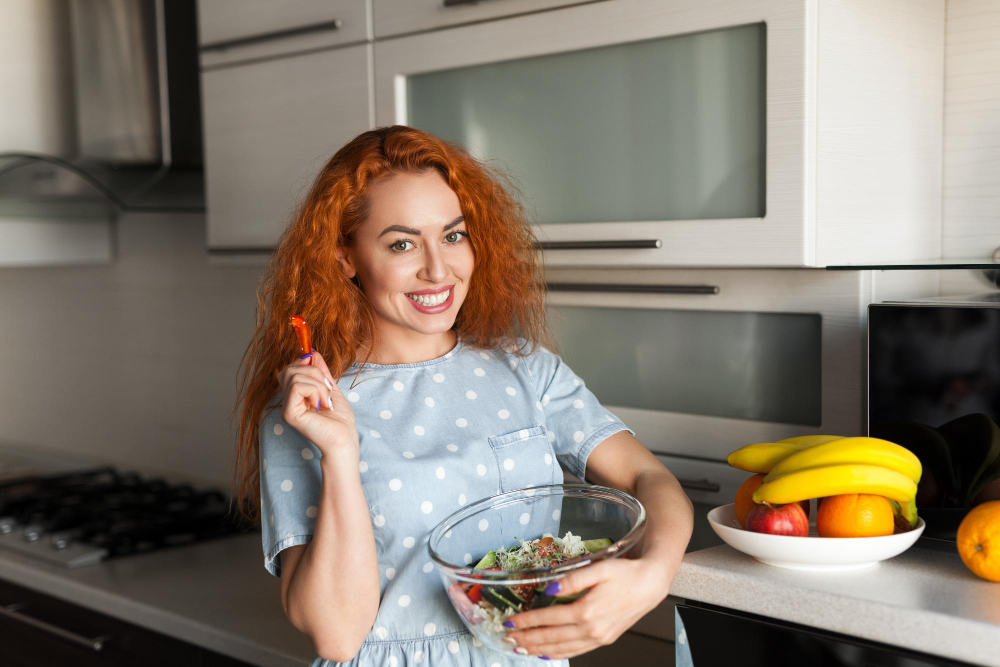Easily digestible diet menu - what can you eat and what products should be avoided?

Easily digestible diet - menu - how to balance it properly? The easily digestible diet is a modification of the basic diet, which is recommended, among other things, in many diseases of the digestive tract. It should be properly balanced, but in order to do so, it is useful to know what products are recommended, and which, in turn, should be avoided on this diet.
What is an easily digestible diet and how to properly prepare a menu to provide the body with all the necessary nutrients?
An easily digestible diet - what is it?
Easily digestible diet is a modification of the basic diet, which involves reducing the proportion of heavy-digestible foods and products in the menu.
An easily digestible diet should fully cover energy requirements and supply the body with the same amount of nutrients as the basic diet.
The easily digestible diet menu is based on easily digestible foods and cooking techniques that make the food easily digestible. On the other hand, the diet limits (and sometimes completely excludes) fatty products and foods that linger in the stomach for a long time and are hard to digest, as well as those that cause bloating and are spicy.

What is the purpose of using an easily digestible diet?
The purpose of an easily digestible diet is to provide the human body with all the necessary nutrients, while sparing the digestive tract.
In addition, the use of an easily digestible diet is aimed at improving health by ensuring the best possible digestion and absorption processes and alleviating any ailments of the digestive system.
When is it worth using an easily digestible diet?
An easily digestible diet is recommended, among others:
- in inflammation of the gastric and intestinal mucosa,
- in gastric and duodenal ulcers,
- before certain tests, such as colonoscopy or abdominal ultrasound,
- during the period of convalescence after surgical procedures,
- in acute and chronic diseases of the respiratory system,
- in gastrointestinal cancers,
- during infections with fever,
- in the nutrition of the elderly and sick people who require prolonged lying down,
- to compensate for kidney and urinary tract diseases,
- in case of feeling of heaviness.
The period of using the easily digestible diet depends on your health, symptoms and doctor's recommendations.
It should be used until there is improvement, which will allow the gradual expansion of the diet and return to the basic menu.
General rules for preparing a menu on an easily digestible diet
When using an easily digestible diet, it is worth relying on boiled and stewed meals. You should avoid fried, deep-fried foods, as well as marinated, smoked and canned foods.
In the daily menu, it is worth including easily digestible products cereals, ripe and delicate fruit and vegetables, lean meats, meat and fish, dairy and low-fat products.
When following an easy-to-digest diet, the daily supply of dietary fiber should not exceed 25 g. Then it is also worth limiting the proportion of insoluble fraction of dietary fiber in the diet, the consumption of which can increase the secretion of digestive juices and gastrin and increase intestinal peristalsis. The insoluble fiber fraction is found in whole grain cereal products, fruits and vegetable seeds, as well as nuts and seeds.
Alcohol is not recommended in any diet, but in the case of an easily digestible diet, it should be especially avoided. Alcohol can irritate the mucous membrane of the stomach and intestines and contribute to the severity of unwanted discomforts such as heartburn and diarrhea.
Recommended products
Products and cooking techniques recommended on an easily digestible diet
On an easy-to-digest diet, the menu should include products such as:
- easily digestible grain products, including wheat bread, fine groats (semolina, barley, millet), rice, fine pastas,
- milk and dairy products such as natural yogurt, kefir, white cheese,
- soft boiled eggs, fried eggs or in the form of steamed scrambled eggs,
- lean meat and cured meats, including chicken, veal, rabbit meat,
- lean fish, such as cod, bream or zander,
- fats - vegetable oils, soft margarines, butter,
- ripe fruits and vegetables, preferably without skin and seeds. It is advisable to use fruits and vegetables in cooked form or in the form of puree,
- still water, diluted juices or delicate compotes,
- Spices such as vanilla, cinnamon, parsley, marjoram, cumin or lemon balm.
Soups are also recommended:
- in the form of gruel,
- prepared on weak broths,
- pure (e.g., borscht),
- milk.
Food should be cooked in water or steamed. Baking in aluminum foil or parchment paper is also allowed. It's also a good idea to puree products through a sieve and fluff up dishes by adding beaten egg whites or soaked bread crumbs to them.
It is a good idea to add fat to dishes at the end of their preparation, so that meals are not saturated with it and hard to digest.
Products, foods and cooking techniques not recommended on an easy-to-digest diet
On an easily digestible diet, it is worth eliminating from your menu products and dishes that may intensify the occurrence of undesirable ailments and hinder the work of the digestive tract. Ingredients that are not recommended in an easily digestible diet include:
- Whole grain cereal products, coarse groats, brown rice, wholemeal pasta,
- fatty meats and cured meats - pork, mutton, duck and goose, and canned meats,
- Fatty fish, such as eel, salmon, carp or catfish,
- cheeses with a high fat content,
- heavily digestible vegetables, i.e. brassica, garlic, onions, cucumbers, leek, sorrel,
- legume seeds,
- heavily digested fruits, i.e. cherries, plumes, dried fruits,
- strong coffee and tea, carbonated and alcoholic drinks,
- hot spices such as chili, allspice, bay leaf, pepper, mustard seed,
- sweets and desserts,
- Fatty, thick and fried soups, spicy and prepared from cabbage vegetables.
Culinary techniques such as frying (especially deep-frying), traditional baking and roasting, and making roux are not advisable.
Example of an easily digestible menu for the whole day
If you already know the theory of an easily digestible diet and know what products are recommended and which are forbidden, it's time to move on to practice!
Below you will find a proposal of meals that will make the menu of an easily digestible diet easy to prepare, tasty and most importantly, easily digestible.

Breakfast - millet with baked apple and cinnamon
It is said that breakfast is the most important meal of the day. After all, the portion of energy with which you start the day depends on breakfast. It should be a wholesome and balanced meal. Millet is just like that - healthy, tasty and nutritious, and easy to digest!
Ingredients needed to prepare the dish:
- 50 g of millet groats,
- 200 ml of milk (or water)
- 1 apple,
- cinnamon.
Method of preparation: Cook the millet groats in milk (or water, as desired). While cooking, constantly stir the contents of the pot. When the groats are soft, add cinnamon and blend the ingredients. Peel the apple, scoop out the seed nest and cut into quarters. Place them in a heatproof dish and put them in the oven or microwave for a few minutes. Bake until it is soft. Add the baked apple to millet, mix and enjoy the taste of a nutritious breakfast with a spicy, cinnamon note.
II breakfast - natural yogurt with banana
A quick snack that will not overload your digestive system is, for example, natural yogurt with banana.
Required ingredients to prepare the dish:
- small package of natural yogurt,
- 1 ripe banana.
Method of preparation: Simply peel the banana and slice it (you can also mash it with a fork for a sweet puree) and add it to the yogurt. Mix the ingredients and a delicious second breakfast is ready!
Lunch - cod baked in parchment with boiled potatoes and steamed carrots
Lunch is the meal that stands out as the most energetic of the day. How about a fish accompanied by boiled vegetables? So simple and so delicious!
Required ingredients:
- 1 cod carcass,
- 4 potatoes,
- 3 carrots,
- olive oil,
- favorite, permitted spices.
Method of preparation: Season the fish with your favorite spices (which are helpful in an easily digestible diet), e.g. parsley and lemon juice. Then wrap in parchment paper and place on a baking sheet. Bake in the oven at 200 degrees for about 35 minutes.
Peel the potatoes, cut them into quarters and boil them. Similarly prepare carrots - peel, slice and steam them. When the vegetables are soft, put them on a plate. Place the baked fish next to it. Gently drizzle the dish with olive oil. Enjoy your meal!
Afternoon snack - wheat roll with cottage cheese and tomato
A quick snack on an easy-to-digest diet? A wheat roll! One, two and the meal is ready!
Required ingredients:
- wheat roll,
- 10 g butter,
- 1 slice of lean cottage cheese,
- 1 tomato.
Method of preparation: Cut bun into two parts, spread with butter. Place a slice of lean cottage cheese inside the bread. Scald and peel the tomato, cut it into slices or quarters and eat it together with a roll of cheese.
Dinner - pumpkin cream
Warming cream soup is perfect for cooler evenings. You can prepare a larger amount at once and treat the rest of the household members with a delicious soup.
Ingredients required to prepare one serving of the dish:
- 150 g pumpkin,
- 50 ml water,
- favorite, permitted spices,
- low-fat milk.
Method of preparation: peel the pumpkin, cut into cubes and put in a pot. Pour in water and cook the vegetables until soft. Then blend the soup and add a little milk if needed. Season with your favorite permitted spices and enjoy the warming pumpkin cream.
As you can see, menu on an easy-to-digest diet is nothing difficult!
Bibliography:
- Jarosz M. (red.) Dietetyka. Żywność, żywienie w prewencji i leczeniu. Instytut Żywności i Żywienia. Warszawa; 2017.
- Kunachowicz H., Nadolna I., Przygoda B., Iwanow K.: Tabele składu i wartości odżywczej żywności. Wydawnictwo Lekarskie PZWL. Warszawa; 2017.
- Chojnacka R. Dieta lekkostrawna czyli jaka? Agrotechnika. Poradnik rolnika. 05.2012

